Pipe Wrench Size Guide
Select your size to see the recommended pipe diameter and typical use.
Looking for the perfect fit? Check Out These Best-Selling Pipe Wrench.
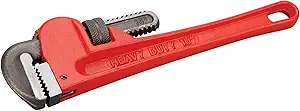
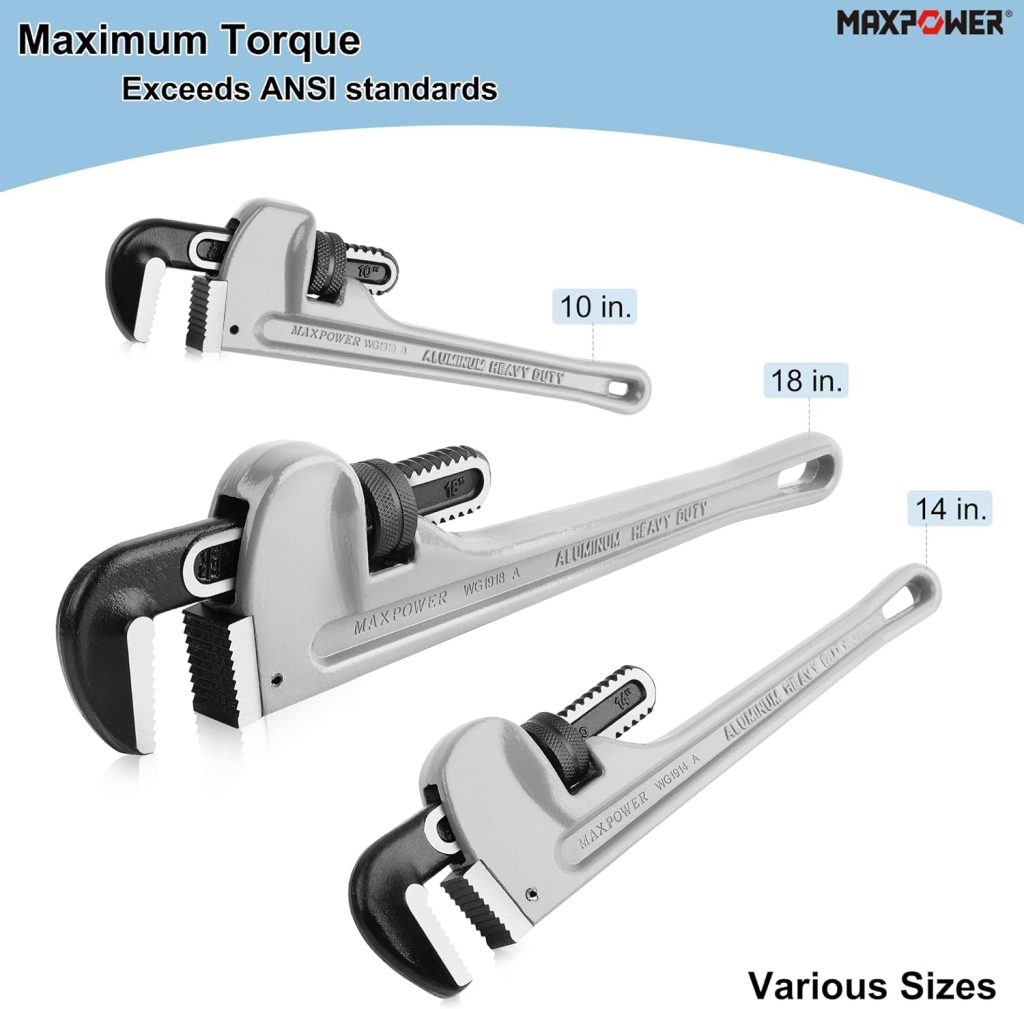
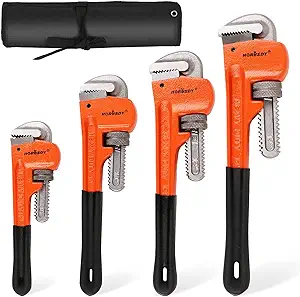
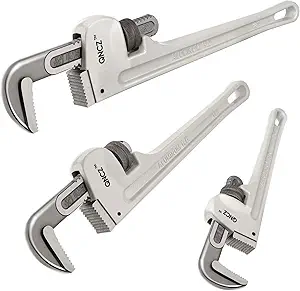
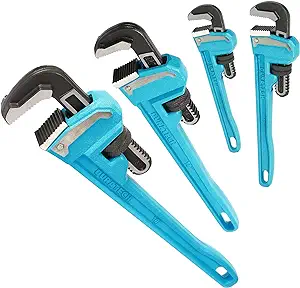

Pipe Wrench Size Guide – How to Choose the Right Size for Your Plumbing Jobs
When it comes to plumbing work, having the right tools can make all the difference between a smooth, efficient repair and a frustrating, time-consuming task. One such essential tool in any plumber’s toolkit is the pipe wrench. Whether you’re a professional plumber or a DIY enthusiast tackling your own home repairs, understanding how to choose the right pipe wrench size is crucial for getting the job done correctly and safely.
We will walk you through everything you need to know about selecting the proper pipe wrench size, including what factors to consider, how to measure pipe sizes, and tips for using pipe wrenches effectively. We will also provide you with a pipe wrench size chart to make sure you choose the correct size for your specific needs.
What is a Pipe Wrench?
A pipe wrench is a robust and adjustable tool used for gripping and turning pipes, usually in plumbing applications. The wrench features serrated jaws that provide a strong grip on round objects, such as pipes and fittings. Pipe wrenches come in various sizes, each designed for different pipe diameters and types of tasks.
While pipe wrenches are traditionally used for plumbing work, they can also be helpful for tasks such as automotive repairs and industrial maintenance. Understanding the correct size of pipe wrench to use is essential to ensuring a secure grip without damaging the pipes or causing excessive strain on your body.
Types of Pipe Wrenches
Before diving into the specifics of pipe wrench sizing, it’s important to understand the different types of pipe wrenches available. These include:
- Straight Pipe Wrench
The most commonly used pipe wrench, featuring a straight handle and jaws. Straight pipe wrenches are ideal for general plumbing tasks, offering a secure grip on pipes for both tightening and loosening. - End Pipe Wrench
This wrench has a shorter, curved handle, which makes it useful for situations where space is limited. It’s a more compact version, designed for working in tight spaces. - Heavy-Duty Pipe Wrench
Heavy-duty pipe wrenches have extra-wide jaws and thicker handles to handle larger pipes or tougher materials. These are typically used in industrial and commercial applications. - Torque Wrench
While not typically used for plumbing, torque wrenches are used to measure the amount of force applied to a fastener. This tool is useful for ensuring precision when working with delicate pipes or threaded fittings.
Why Does Pipe Wrench Size Matter?
Choosing the right pipe wrench size is essential for a number of reasons:
- Proper Grip: Using the wrong-sized wrench can result in a poor grip, making it harder to turn the pipe or fitting. A poorly-sized wrench may slip off, causing damage to both the pipe and the wrench.
- Pipe Damage: A pipe wrench that is too small or too large for the pipe can result in unnecessary damage. Small wrenches can crush the pipe, while oversized wrenches may leave gaps and fail to securely grip the pipe.
- Efficiency: The right size wrench allows you to work more efficiently and with greater precision. A wrench that fits the pipe well provides better leverage, making it easier to apply force and move the pipe or fitting.
- Safety: Using a pipe wrench of the correct size helps to reduce the risk of injury. If a wrench slips off a pipe due to improper size, it can cause damage to the surrounding area or even to the person using it.
How to Choose the Right Pipe Wrench Size
To choose the proper pipe wrench size, there are several factors to consider:
1. Pipe Diameter
The first and most important factor in choosing the right pipe wrench is the size of the pipe you’re working with. Pipe wrenches are designed to handle different pipe diameters, and using the right wrench will ensure a secure grip.
Pipe wrenches typically handle pipe diameters between 1/8 inch and 48 inches, but the most common sizes are for pipes with diameters of 1/2 inch to 6 inches.
2. Length of the Wrench Handle
The length of the handle determines the leverage a pipe wrench can provide. Longer handles allow you to apply more force and are better suited for larger, tougher jobs. Shorter handles, on the other hand, are more compact and ideal for working in tight spaces.
For example, a pipe wrench with a 14-inch handle is typically used for small pipes, while a 36-inch or longer wrench is better for large commercial plumbing jobs.
3. Adjustable Jaw Mechanism
Most pipe wrenches come with an adjustable jaw mechanism that can be expanded or contracted to fit different pipe sizes. The wrench should be adjusted to the pipe’s diameter for the best grip. Ensure the adjustable mechanism is tight enough to prevent slippage, but not too tight, as it can damage the pipe or the wrench.
4. Pipe Material
The material of the pipe can also impact the type of pipe wrench you need. Different materials, such as copper, PVC, or cast iron, may require a different type of jaw or grip to prevent damage. For softer materials like copper, consider using a pipe wrench with softer, non-marring jaws, while for tougher materials like cast iron, a standard serrated jaw will work best.
5. Weight and Durability
The weight of the pipe wrench is another factor to consider. A heavier wrench may provide more power and durability, but it could also be more difficult to maneuver. Lighter wrenches are easier to handle and more suitable for delicate jobs, while heavy-duty models are designed to withstand the stress of more demanding tasks.
Pipe Wrench Size Chart
To help you select the right pipe wrench size for your plumbing tasks, here’s a general guide:
| Wrench Size (inches) | Recommended Pipe Diameter (inches) | Typical Use |
|---|---|---|
| 10-inch | 1/8″ – 1″ | Small plumbing jobs, tight spaces |
| 14-inch | 1/2″ – 1 1/2″ | Residential plumbing tasks |
| 18-inch | 1″ – 2 1/2″ | General plumbing, residential jobs |
| 24-inch | 1 1/2″ – 3″ | Commercial plumbing, larger pipes |
| 36-inch | 2 1/2″ – 4″ | Industrial plumbing, large pipes |
| 48-inch | 3″ – 6″ | Heavy-duty plumbing, industrial work |
Tips for Using Pipe Wrenches
- Leverage is Key: Apply force slowly and steadily. Do not overexert yourself, as this can lead to injury or damage to the pipe.
- Use the Right Wrench for the Job: For very large pipes or tough materials, use a heavy-duty wrench with a longer handle. For smaller jobs, a compact wrench with an adjustable jaw is sufficient.
- Lubricate the Threads: If the pipe is rusted or difficult to move, applying a lubricant can make it easier to turn without damaging the threads.
- Protect the Pipe: If you’re working with soft materials like copper or plastic, consider using a non-marring pipe wrench to avoid damaging the surface of the pipe.
- Regular Maintenance: Keep your pipe wrench clean and free from rust to ensure its longevity and reliability. Regularly check the adjustable jaw for tightness.
Conclusion
Choosing the right size pipe wrench is an essential part of any plumbing job. Whether you’re tightening a small pipe or dealing with a large industrial system, understanding how to select the right wrench size for your needs will help you work more efficiently, safely, and effectively. By considering the diameter of the pipe, the type of wrench you need, and the length of the handle, you’ll be well-equipped for all your plumbing tasks.
Remember to always consult the appropriate size chart and select a pipe wrench that fits your specific job requirements. With the right tools and proper techniques, you can tackle any plumbing job with confidence.
Happy plumbing!






